

Mary of Guise. A Short History of Scotland, by Andrew Lang on Undiscovered Scotland: XVII: Arran & XVIII: Mary of Guise. Chapter XVII: Regency of Arran The death of Cardinal Beaton left Scotland and the Church without a skilled and resolute defender.
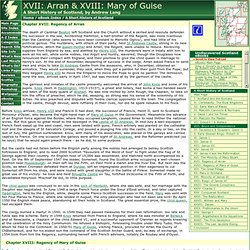
His successor in the see, Archbishop Hamilton, a half-brother of the Regent, was more licentious than the Cardinal (who seems to have been constant to Mariotte Ogilvy), and had little of his political genius. The murderers, with others of their party, held St Andrews Castle, strong in its new fortifications, which the queen-mother and Arran, the Regent, were unable to reduce. Marie de Guise - Renaissance, Reformation and Mary Queen of Scots.
After his first French wife (Madeleine of Valois) died, James V planned a second marriage to cement the renewed Auld Alliance.
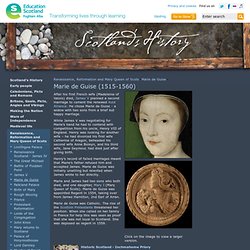
He chose Marie de Guise - a widow with two sons from a brief but happy marriage. While James V was negotiating for Marie’s hand he had to contend with competition from his uncle, Henry VIII of England. Henry was looking for another wife – he had divorced his first wife Catherine of Aragon, beheaded his second wife Anne Boleyn, and his third wife, Jane Seymour, had died just after giving birth. Henry’s record of failed marriages meant that Marie’s father refused him and accepted James. Marie de Guise was initially unwilling but relented when James wrote to her directly. Marie of Guise, Queen of Scotland. Marie of Guise, c. 1537, by Corneille de Lyon Marie of Guise was born on November 22, 1515 in the castle of Bar-le-Duc in northeast France.
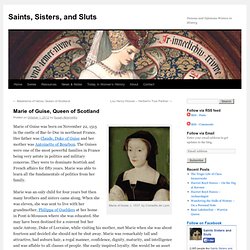
Her father was Claude, Duke of Guise and her mother was Antoinette of Bourbon. Mary of Lorraine, or Mary of Guise (1515-1560) MARY OF LORRAINE, generally known as MARY OF GUISE, queen of James V and afterwards regent of Scotland, was born at Bar on the 22nd of November 1515.
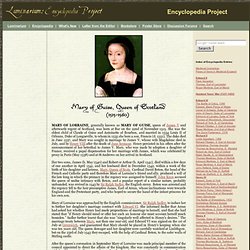
She was the eldest child of Claude of Guise and Antoinette of Bourbon, and married in 1534 Louis II of Orleans, Duke of Longueville, to whom in 1535 she bore a son, Francis (d. 1551). The duke died in June 1537, and Mary was sought in marriage by James V, whose wife Magdalene died in July, and by Henry VIII after the death of Jane Seymour. Henry persisted in his offers after the announcement of her betrothal to James V. Mary, who was made by adoption a daughter of France, received a papal dispensation for her marriage with James, which was celebrated by proxy in Paris (May 1538) and at St Andrews on her arrival in Scotland. Her two sons, James (b. Mary of Lorraine was approached by the English commissioner, Sir Ralph Sadler, to induce her to further her daughter's marriage contract with Edward VI.
Excerpted from: Other Local Resources: Scotland's History - James V marries Mary of Guise. Who was Mary of Guise? Who was Mary of Guise A towering figure in Scottish Renaissance history, Mary of Guise was partly educated in a convent but ended her life in Scotland at the helm of a kingdom torn by war and religious strife.
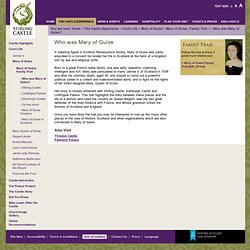
Born to a great French noble family, she was witty, beautiful, charming, intelligent and rich. Mary was persuaded to marry James V of Scotland in 1538 and after his untimely death, aged 30, she stayed to carve out a powerful political career in a violent and male-dominated world, and to fight for the rights of her infant daughter Mary, Queen of Scots. Her story is closely entwined with Stirling Castle, Edinburgh Castle and Linlithgow Palace. This trail highlights the links between these places and the life of a woman who ruled the country as Queen Regent, was the last great defender of the Auld Alliance with France, and whose grandson united the thrones of Scotland and England.
Also Visit. Untitled. John Knox; Mary of Guise, Queen Regent; and the First Reformation.
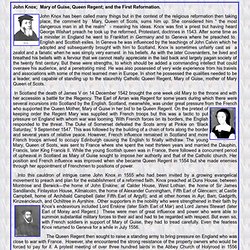
John Knox has been called many things but in the context of the religious reformation then taking place, the comment by Mary, Queen of Scots, sums him up. She considered him “ the most dangerous man in all the realm” - meaning his ideas. On this day in history - Mary of Guise died. Marie de Guise, Queen Consort of Scotland (1515 - 1560.
Mary of Guise. Mary of Guise - the Widowed Queen. Mary of Guise She was a beautiful, witty, clever single mother.

French born, she rose to become the regent of Scotland, and mother of Mary Queen of Scots. The life of the ‘other’ Mary – Mary of Guise – had as much drama and intrigue as her more famous daughter. Yet much less is known about the Queen who was perhaps one of Renaissance Scotland’s most remarkable figures. Such is the importance of this “Renaissance woman” that Historic Scotland has produced a new Family Trail, highlighting Mary of Guise’s life and her links with Stirling, Linlithgow and Edinburgh Castle. Supremacy and Survival: The English Reformation: Mary of Guise, Mother and Regent. Born November 22, 1515--doesn't that portrait look like a real person?
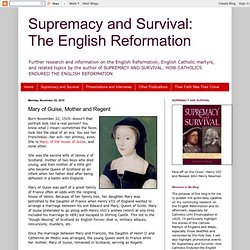
You know what I mean--sometimes the faces look like the ideal of an era. You see her Frenchness--her will--her whimsy, even. She is Mary, of the house of Guise, and none other. She was the second wife of James V of Scotland, mother of two boys who died young, and then mother of a little girl who became Queen of Scotland as an infant when her father died after being defeated in a battle with England. 533 Castlehill, Palace And Chapel Of Mary Of Guise Details Details. The End of Mary of Guise's Regency. Mary of Guise When the Queen Regent marched back into Edinburgh her army consisted of three thousand Frenchmen, a number of Scots and even a few English mercenaries.
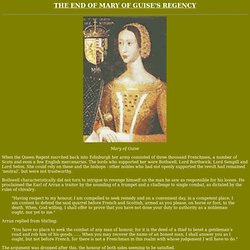
The lords who supported her were Bothwell, Lord Borthwick, Lord Sempill and Lord Seton. She could rely on these and the bishops - other nobles who had not openly supported the revolt had remained ‘neutral’, but were not trustworthy. Bothwell characteristically did not turn to intrigue to revenge himself on the man he saw as responsible for his losses. He proclaimed the Earl of Arran a traitor by the sounding of a trumpet and a challenge to single combat, as dictated by the rules of chivalry: "Having respect to my honour, I am compelled to seek remedy and on a convenient day, in a competent place, I am content to defend the said quarrel before French and Scottish, armed as you please, on horse or foot, to the death. Arran replied from Stirling: Continue....
Back to Earl of Bothwell Index Back to the Library Back to Homeworld. Mary de Guise (1515-1560) - Explore-Parliament.net. Mary de Guise (1515-1560) © 2007 Armchair Travel Co.
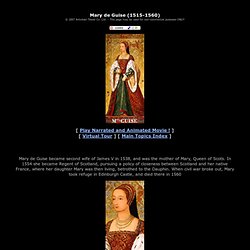
Ltd. - This page may be used for non-commercial purposes ONLY! [ Play Narrated and Animated Movie ! ] [ Virtual Tour ] [ Main Topics Index ] Encyclopedia.com articles about Mary of Guise. Mary of Guise Archives. Mary of Guise Barge (The Shore, Leith, Edinburgh) Mary of Guise Barge. Mary of Guise, 1515 - 1560. Queen of James V − Corneille de Lyon − L. The daughter of a French duke, Mary of Guise had just been widowed when she was married to James V to strengthen the alliance between France and Scotland. Their two sons died in infancy and James died a few days after their daughter, Mary, was born in 1542. Mary of Guise chose to stay in Scotland, ruling as Regent to protect her daughter's interests. Although courageous and determined, her efforts to keep the country in the French Roman Catholic sphere were unsuccessful and she failed to stem the rising tide of Protestantism.
Corneille de Lyon (French, about 1500 / 1510 - about 1575) Born in The Hague, little is known of this artist's early life or training. Mary of Guise fine art prints. Mary of Guise, 1515 - 1560. Queen of James V. Person - Mary of Guise.